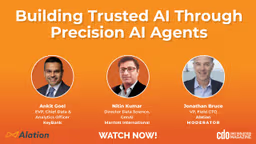Opinion & Analysis
30+ Years in Data — How Dow’s Chris Bruman Leads on Innovation, Access, and Purposeful AI
Dow’s Chief Data & Analytics Officer reflects on three decades of transformation and explains how the company is unlocking enterprise-wide value through data democratization, AI, and a unified strategy.
Written by: Pritam Bordoloi
Updated 11:58 AM UTC, Wed April 9, 2025

With a presence in over 160 countries and manufacturing sites in 30, Dow is one of the world’s leading suppliers of chemicals and plastics. For a company of this scale, leveraging data is essential to optimize supply chains, ensure regulatory compliance, drive innovation, and advance sustainability.
Leading Dow’s data-driven transformation is Chief Data & Analytics Officer (CDAO) Chris Bruman, a company veteran with over 30 years of experience. He has witnessed the evolution of data’s role in business and played a pivotal role in shaping Dow’s modern data strategy.
As CDAO, Bruman leads the centralized Enterprise Data and Analytics team, ensuring the right strategy, top-tier talent, and high-impact solutions. He’s also responsible for ensuring Dow extracts tangible value from data, analytics, and AI — turning insights into real business impact.
In this exclusive interview, Bruman explains how Dow has long been ahead of the curve in data and technology investments. He also explores Dow’s evolving data strategy, the strategic use of Generative AI (GenAI), data democratization, and the shifting responsibilities of the modern CDAO.
Edited Excerpts
Q
Having been with Dow for over 30 years, how have you seen the role of data and analytics evolve? In what ways has it influenced Dow’s transformation and decision-making processes?
A
Dow has been ahead of the game with the use of data for some time. We were building enterprise-wide data warehouses by the early 90s. Given our focus on chemistry and engineering, we also have been using AI for more than two decades, so we aren’t at all new to data and analytics. I would describe the largest evolution being the decentralization of reporting or data democratization. We are in the process of moving to a hub-and-spoke model that empowers our users across Dow to have easier access to building their own analytics capabilities.
Q
Many large enterprises struggle with data silos across departments and systems. How has Dow tackled data fragmentation to ensure seamless access to high-quality, integrated data across the enterprise?
A
I mentioned data democratization in my previous response. We got there through a significant focus on our Integrated Data Hub, built on Azure and Databricks. With this hub, we now have data from across almost every function and business of the company, allowing data analysts and scientists to stitch together various datasets to build models.
We have strict guidelines around data going into the data hub, including clear data product ownership, good metadata, and data quality requirements. This ensures the decisions we are making with that data are accurate.
Q
As AI continues to reshape industries, how has Dow’s data strategy evolved — particularly in the age of GenAI?
A
From a traditional AI standpoint, the most significant change to our strategy is the introduction of the Integrated Data Hub. For the first time, our data scientists can go to one place to get data from across the company.
Of course, GenAI has brought new focus and has democratized the use of AI for almost every employee. Its introduction also has brought changes to our strategy around training, security, data privacy and responsible AI. Our Responsible AI framework and principles guide Dow’s use of both traditional and GenAI.
Q
Can you share specific examples where AI or predictive analytics has driven measurable improvements in operations or strengthened Dow’s competitive edge?
A
We have several examples. We use predictive analytics for demand forecasting as an example. We have seen much more accurate forecasting, which allows us to optimize inventory and run our operations in a more consistent manner.
In the commercial area, we use predictive analytics for processes such as intelligent pricing, predicting product delivery issues, and missed order opportunities. Lastly, we are using AI to get earlier signals regarding issues with our manufacturing assets, driving down maintenance costs and reducing unplanned events.
Q
Is Dow’s digital transformation focused primarily on internal efficiencies, or does it extend to partners and the broader ecosystem?
A
We are working on both internal and external capabilities. Our most obvious external impact around digital transformation is the evolution of our Dow.com B2B platform. We now make product information, order management and sustainability information easily available via Dow.com. We integrate intelligence to better predict things like order delivery timing.
We’re also leveraging digital to enable stronger engagement with customers as we build new formulations for them in our research and development space.
Q
What are some of the most promising GenAI use cases you’ve explored at Dow? Are there any unique challenges in applying GenAI within your industry?
A
We have been very purposeful when it comes to GenAI. We have avoided launching dozens of projects and instead are focused on the handful of most impactful business challenges where GenAI can make a difference.
One use case that has a lot of applicability and value is offering the opportunity for our employees to quickly parse very detailed documents to get information. An example is in the patent space, which is critical for Dow. We have reduced the time it takes to review patents as we do new research from months down to weeks or even days.
I don’t think the GenAI challenges are unique to our industry. We must keep our critical data within the walls of Dow, so we only allow employees to use pre-approved LLMs where we know we have data protection. We also count on those strategic partners to indemnify us from copyright infringement, which is obviously another risk with GenAI. But these aren’t specific to our industry.
Q
Looking ahead, how do you see the role of the Chief Data and Analytics Officer evolving over the next 5–10 years? What emerging data and technology trends excite you the most?
A
As it has for the past few years, the CDAO role will continue to grow in importance for companies as they look to harvest value from data, analytics and AI. The leaders in those roles will have a significant impact on profitability and therefore be viewed more as a business leader versus an IT leader. As executives learn more about this space, they are going to look to data and analytics to solve those key business challenges they’re facing and be one of their top “tools in the toolkit.”
While there has been significant hype over GenAI these past couple of years, I don’t think we’ve really seen anywhere near the full impact. Certainly, it’s become a great productivity enabler with tools like Microsoft Copilot.
An example of what has yet to be fully deployed is how users will interact with applications. Take ERP as an example. I would expect that before too long, users of ERP systems will be able to use natural language to execute tasks versus flipping through a bunch of screens and filling out fields. This will drive a big change in how we work and the level of training we need when it comes to using those tools.





